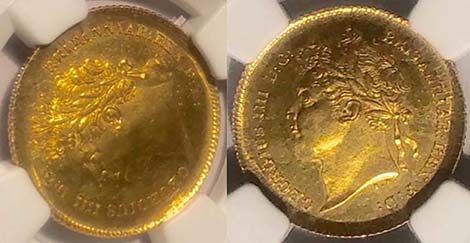A die cap is caused when a struck coin sticks to the upper hammer die. Once the coin is stuck to the die face, the reverse of the struck coin becomes the new die face. When the next blank is fed into the collar and the strike occurs, the reverse design of the adhered struck coin impresses itself into the new blank. This struck coin is a brockage strike. The coin that adhered to the upper die is known as a die cap. This process repeats itself as more coins are struck by the cap. The greater the number of strikes, the higher the cap metal will be pushed around the upper die shaft. Eventually, the cap brakes away from the die in the shape of a thimble.
Pictured above is the only known obverse die cap struck in gold from any country. It was certified and authenticated by NGC. It is an English Half Sovereign dated 1824 of King George IV. This happens to be an extremely rare date in the English Half Sovereign series and is also in gem mint state condition.
After being struck, this gold coin adhered to the obverse die and became an obverse die cap. It subsequently struck several blank planchets, creating brockages on the obverse of each coin. The reverse design of this die cap expanded with each strike. As with any obverse die cap, the shape resembles a thimble or bottle cap.
